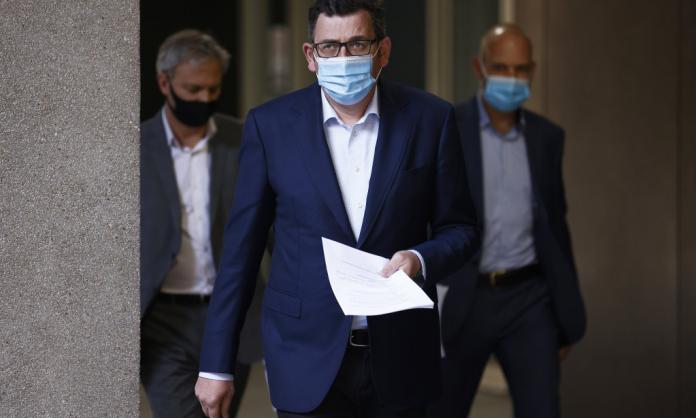The numbers are bad in Victoria today—and the government response is worse.
It would be possible to respond to the increasing viral spread by implementing emergency measures—for instance, by shutting down more businesses to match New Zealand’s level four restrictions; making workplace health and safety a major topic of public discussion, debate and action; and (most urgently) flooding affected communities with financial support.
Instead, Victorian Premier Daniel Andrews has decided to give up on the goal of zero COVID. This decision will have appalling consequences.
COVID cases reported today spiked to 120, with dozens of unlinked cases emerging in working-class suburbs in Melbourne’s north and west. A woman in her 60s is dead in the northern suburbs. Another woman in her 40s is dead in the inner north—the first COVID fatalities in Victoria this year.
Today’s grim COVID numbers coincided with an intensification of the push by corporate Australia to “live with the virus”. Every newspaper in the country has full page ads signed by dozens of Australia’s biggest companies urging governments to open up.
Andrews has not been a forthright advocate of a COVID zero position for some time. By signing on to the national cabinet plan, with its vague promises of reopening, Andrews had left the door open to the push by the business lobby to abandon Australia’s zero COVID status.
This ambiguity was evident at Tuesday's press conference, when Andrews flagged that though the public health response was still designed to “drive towards zero”, this might not be achieved. Unless we were “driving towards zero”, Andrews told us, we would end up with “multiple zeroes” in our case numbers—that is, case numbers in the thousands.
On Wednesday, however, any ambiguity was gone. The rhetoric flipped 180 degrees. Andrews ruled out a return to zero community spread: “We will not see these case numbers go down. They are going to go up. The question is, by how many and how fast?”
The content of Andrews’ message today was identical to the daily press conferences by NSW Premier Gladys Berejiklian: lockdown will continue not with the aim of reducing community spread to zero, but to allow “opening up” when 70 percent and 80 percent of the adult population has been vaccinated (that’s only 55 to 65 percent of the total population).
As worldwide experience is showing, and as health workers and professionals are urgently warning, deciding to “live with covid” is a recipe for death and ill health on a massive scale. The shift in position of the Victorian government is a massive boost for the corporations and politicians who have been barracking for us to “live with COVID” for many months now.
Did Andrews have an alternative?
He claims to have “done everything that we could” to stop this particular outbreak. While it’s true that the Victorian government locked down faster and harder than the NSW government, there is an enormous amount more that could have been done—and still could be, if the political will were there.
Delta is two or three times more infectious than the strain that Victoria defeated last year. But Victoria’s medical, public health, and social defences against a wave of the virus haven’t been built up to be two or three times stronger—quite the contrary. Health and hospital services are at least as stretched as they ever have been. And the crucial financial supports are much more threadbare this year than in 2020.
In multiple press conferences, Andrews and his public health advisers have noted that the single thing that would make the biggest difference to case numbers is people getting tested at the earliest onset of symptoms, rather than soldiering on for days. One of the factors here has to be money.
When the support available is an obscure disaster payment rather than last year’s double dole and JobKeeper, there is less money flowing around households and extended families. This puts enormous pressure on individual workers to keep going, despite symptoms. An announcement of unlimited paid sick leave, and compulsory inductions at each workplace to inform workers of this entitlement, would definitely be doable as a stopgap measure.
The lockdown could also be extended to shut many more non-essential businesses. Exposure sites listed in Victoria over the past day include a distribution centre for a surf wear company, a glass manufacturing business supplying commercial construction, a construction site in Port Melbourne, and a marketing company in Richmond. The world could do without these activities for a time, with staff sent home on income support, while we get cases to zero.
Though New Zealand is still battling a Delta outbreak, the effective reproduction rate of the virus has reportedly been forced below one. A stricter lockdown is part of this. There is no construction permitted in New Zealand’s level four lockdown measures, whereas in Victoria the industry has been operating on 25 percent workforce for big sites and a maximum of five workers on small sites. Takeaway food is shut under New Zealand’s level four—meaning many thousands of workers aren’t required to work in restaurants and cafes. Childcare centres are shut, with in-home care allowed for kids of essential workers. Small shops like milk bars operate with a strict “one in, one out” restriction on customers.
All of these measures could be rapidly adopted.
Emergency action would also be possible to implement stringent safety measures in genuinely essential workplaces. The decline and retreat of the union movement in Australia means there is a massive shortfall in capable, zealous health and safety representatives in almost every industry. This long-term weakness will have consequences measured in health and lives lost.
WorkSafe has been in witness protection during the pandemic: has there been even a single fine levied on non-compliant businesses? Fostering a daily discussion of workplace infections and mitigation measures (such as rostering, HEPA filters, masking) could be a part of every daily briefing, with the aim of mobilising workers themselves to impose and enforce safety measures.
To assist this, it would be possible to deputise unionists as “authorised officers” to conduct audits of every workplace. The results should be public. There is much less information released to the public about workplace transmissions than there was at this time last year. Penalties on workers for speaking out could be removed as an urgent public health measure.
All of these measures would be doable. None of them seem to have even been contemplated, judging from the daily briefings. Door to door, street by street testing could also be considered.
Though Andrews has ruled out a return to face-to-face learning this term, the year 12 “General Achievement Test” is still going ahead on 5 October. This means that every year 12 student in the state will be required to attend school on that day—an incredibly reckless policy in a situation of escalating community spread of the virus.
Supposedly, all year 12 students will have an opportunity to get a first dose of Pfizer before this date. But one dose is relatively ineffective in preventing infection, and many students will only just have been vaccinated. It takes seven to fourteen days to get the full effect of a vaccine.
The whole history of the virus shows that schools have the potential to be significant flashpoints over whether to relax restrictions, and how far and how fast we adopt a brutal new “business as usual” at the expense of lives and public health. There will be many other points of resistance. But the decision of the Andrews government to surrender on the crucial issue of returning to zero COVID is a major boost for the reactionary forces that want to force us to “live with”, and die with, this virus. No one is coming to save us, except ourselves.









